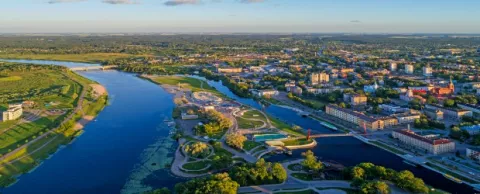
Jelgava is Latvia’s fourth-largest city, but with a population of just 61,000, it’s still considered a micro city. However, according to the Financial Times investment research department fDi intelligence research, Jelgava ranks six among micro cities (those with a population less than 100,000) in the “Connectivity” category and ninth in terms of “Strategy of attracting foreign investors.” The city is becoming known as an economically developed centre of knowledge, technologies and innovation. In 2010, Jelgava set forth a goal to become a modern and sustainable environment by increasing the use of renewable energy sources, improving the transportation sector and promoting energy efficiency. It’s been less than a decade and the city has achieved a number of its goals thanks to the connection of IT and city management services, working with tools like a cloud system and Internet of Things. Let’s take a look at some of the ways Jelgava is paving the way for progress in Latvia.
A connected city
Jelgava has pinpointed one important piece of information: 70 percent of people have a smartphone. In an effort to become a smarter city, Jelgava has made the connection between citizens and city infrastructure, introducing innovative solutions in sectors like welfare administration. Working with Near-field communication (NFC) technology, a type of wireless data transfer, the city was able to link municipality-provided welfare programmes to a “Visa” or “Mastercard” citizen card that can be used with contactless payments via mobile.
This is just one of the ways Jelgava is attending to its citizens’ needs and making municipal services more streamlined. The city also runs an Operative Information Centre with a 24/7 reception for complaints and suggestions; operates nonstop monitoring of infrastructural objects like streetlights and pumping stations; and provides public territory and object video surveillance. As one of its goals to improve the transportation sector, Jelgava has introduced everything from street light control systems and wireless vehicle detections solutions to flooding alert systems and an interactive map and mobile application to help citizens get from point A to point B more efficiently. Valmiera, which lies 100 kilometres northeast of capital Riga, is an even smaller city in terms of population, just shy of 25,000 residents. Yet this 18-square-kilometre city was Latvia’s first to develop a city smartphone application, “My Valmiera,” in cooperation with Riga-based mobile operator Latvian Mobile Telephone.
According to Janis Vilmanis, Chairman of the Board at modern engineering solutions firm FIMA, “There are several cities in Latvia that have implemented the principles of smart cities and not only are they becoming more and more friendlier to local citizens, they’re also gaining economic benefits from the introduction of intelligent systems, for example by limiting the consumption of energy resources and reducing the necessary financial resources. Also, very important, is the active involvement of the local population in the decision-making process and future development of city life.”
Both of these cities prove that by listening and engaging with residents—and offering connected city management services and tools that can be used by the government and citizens themselves—the municipality becomes more accessible while making the quality of life more comfortable at the same time.



